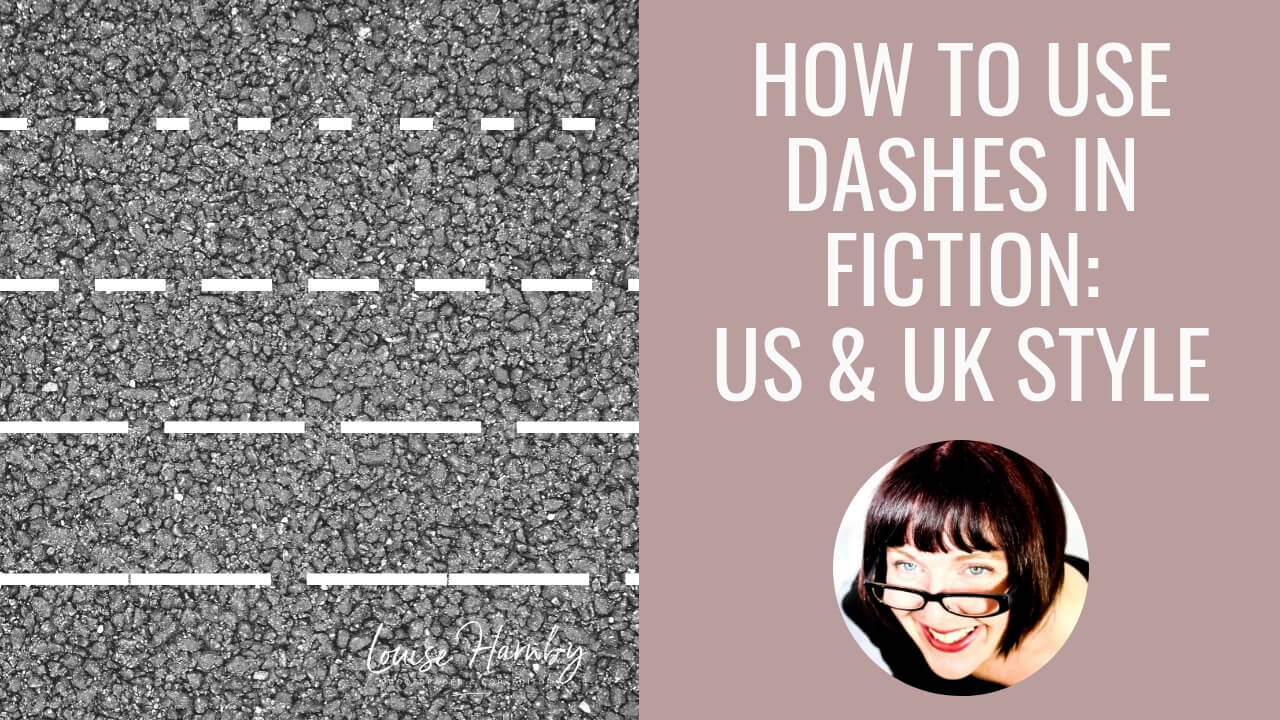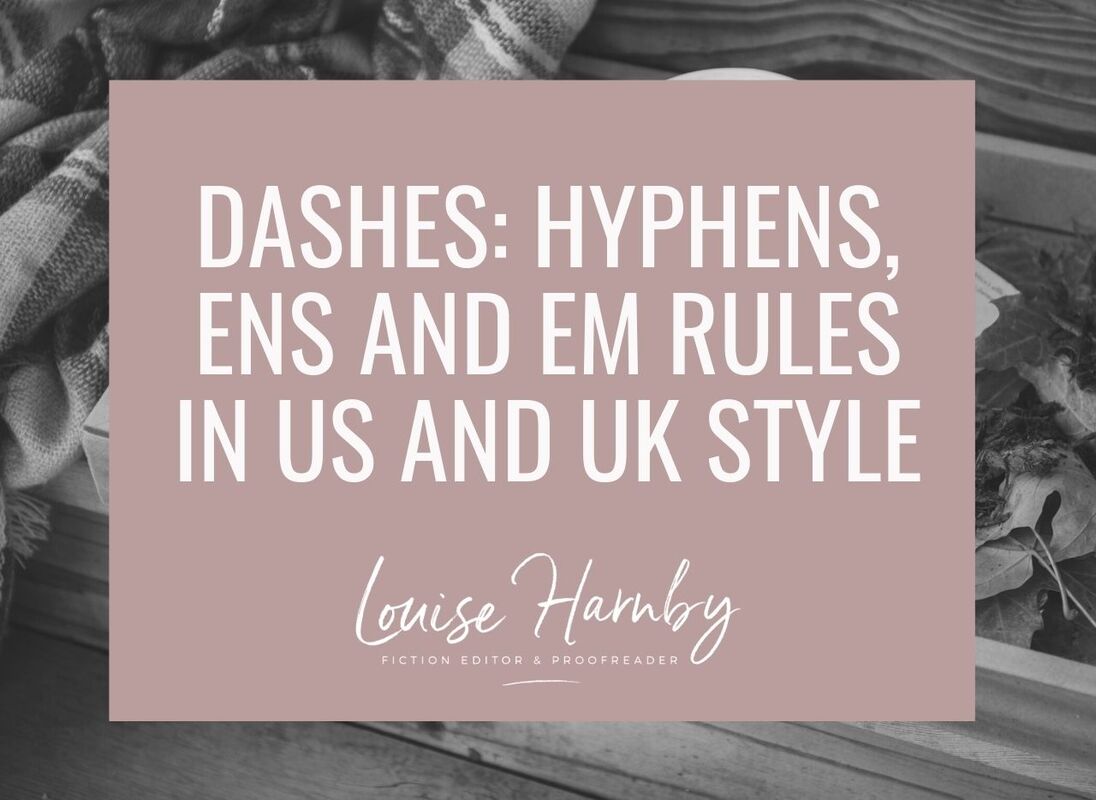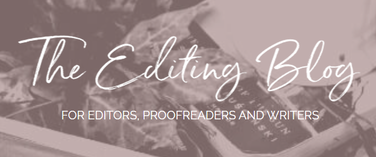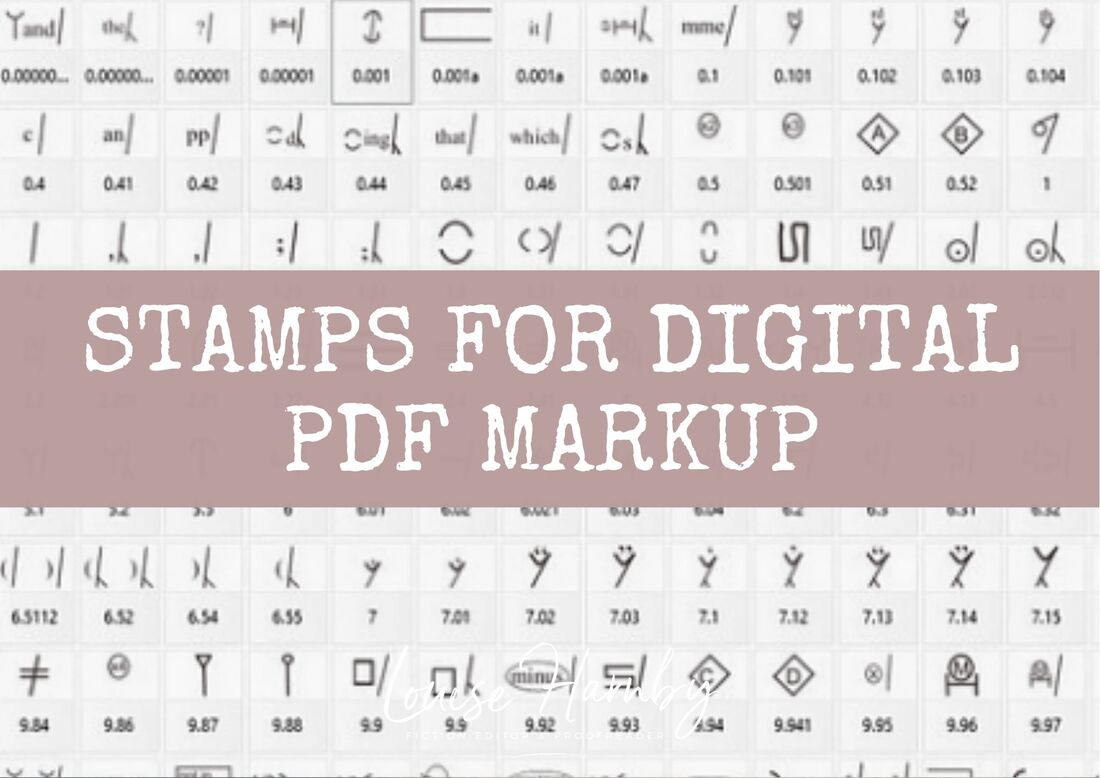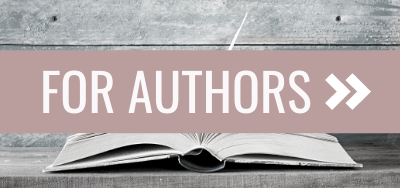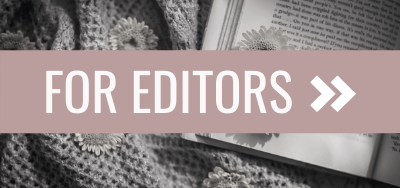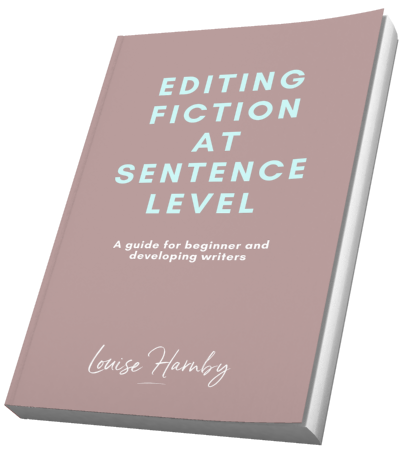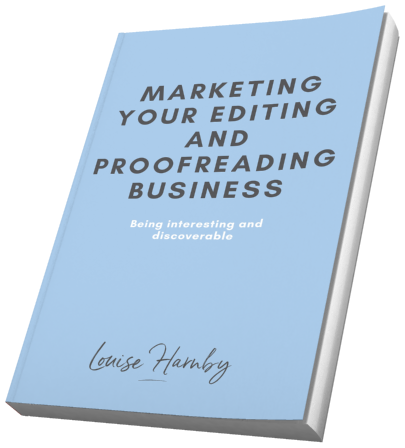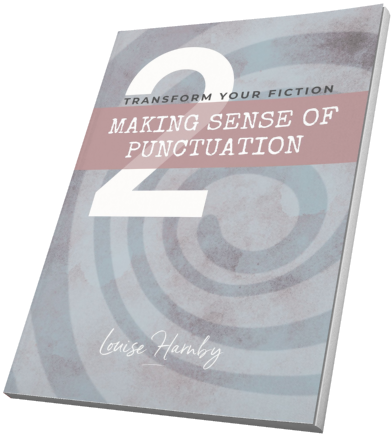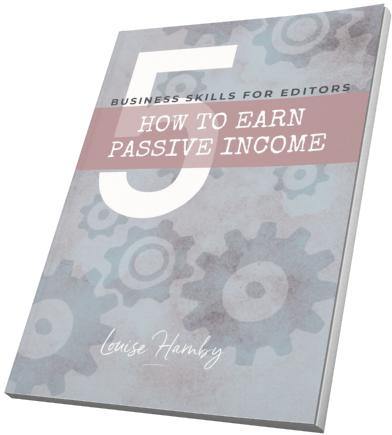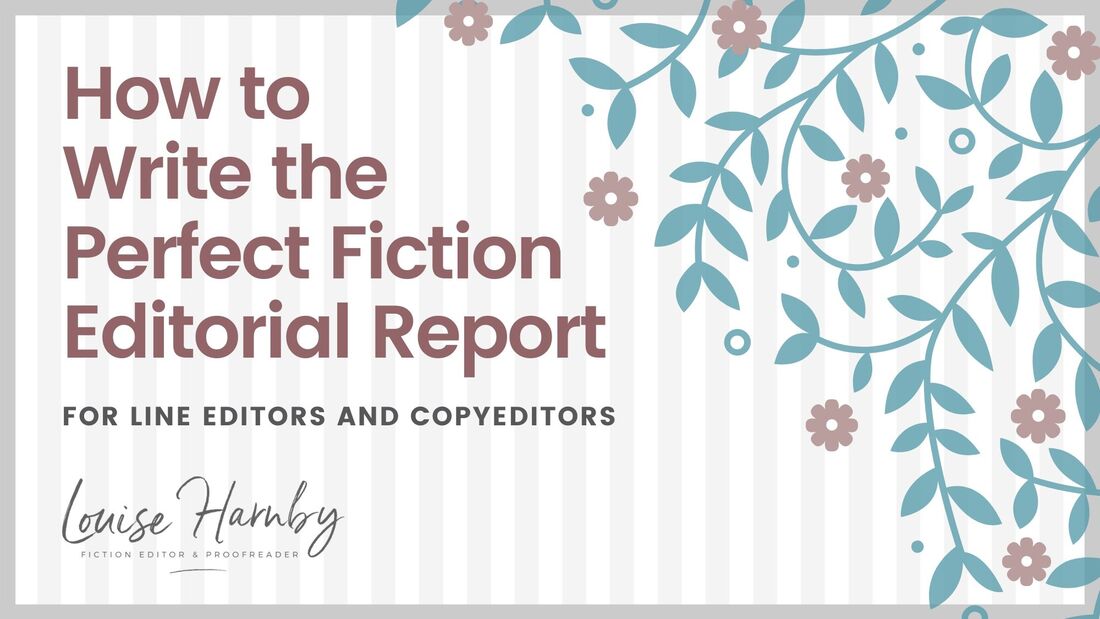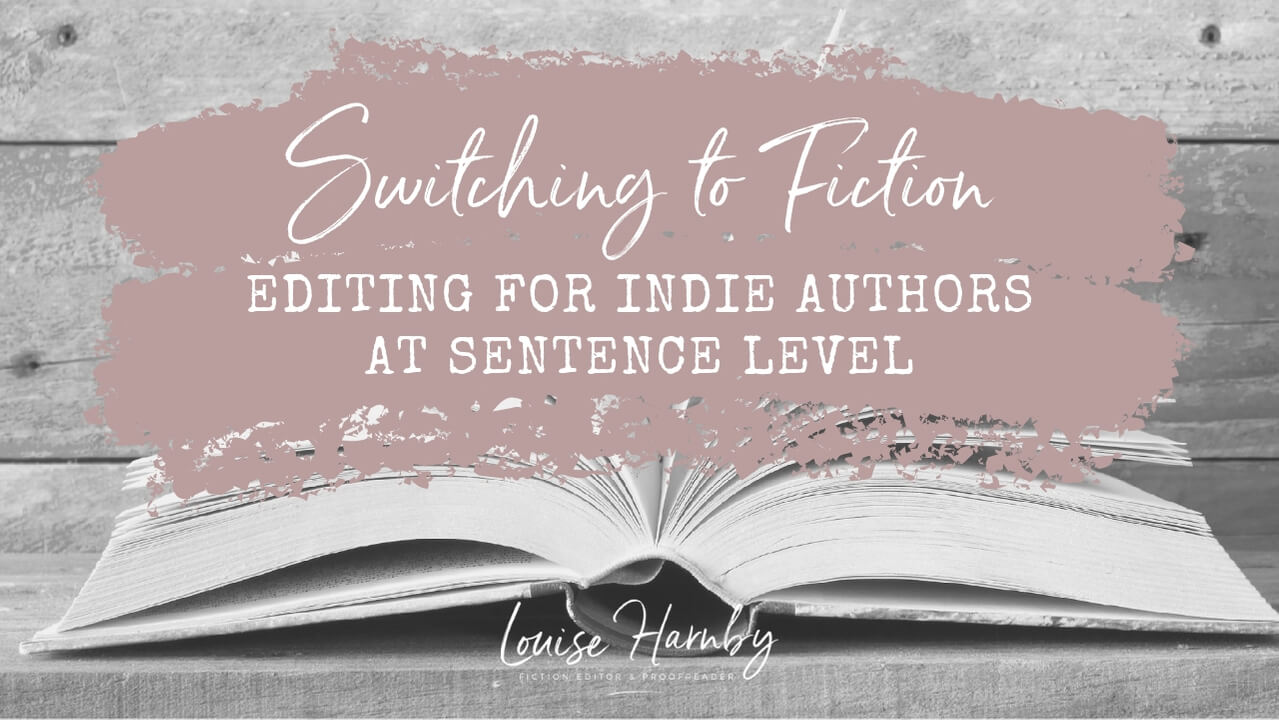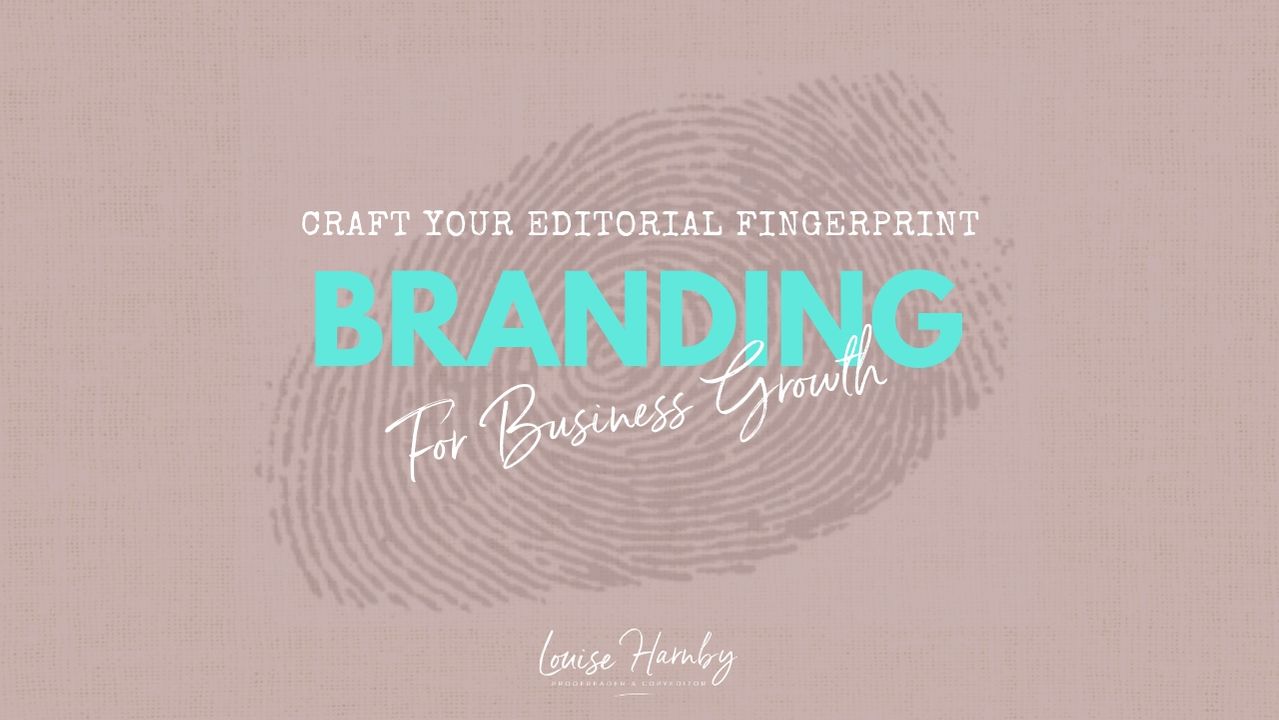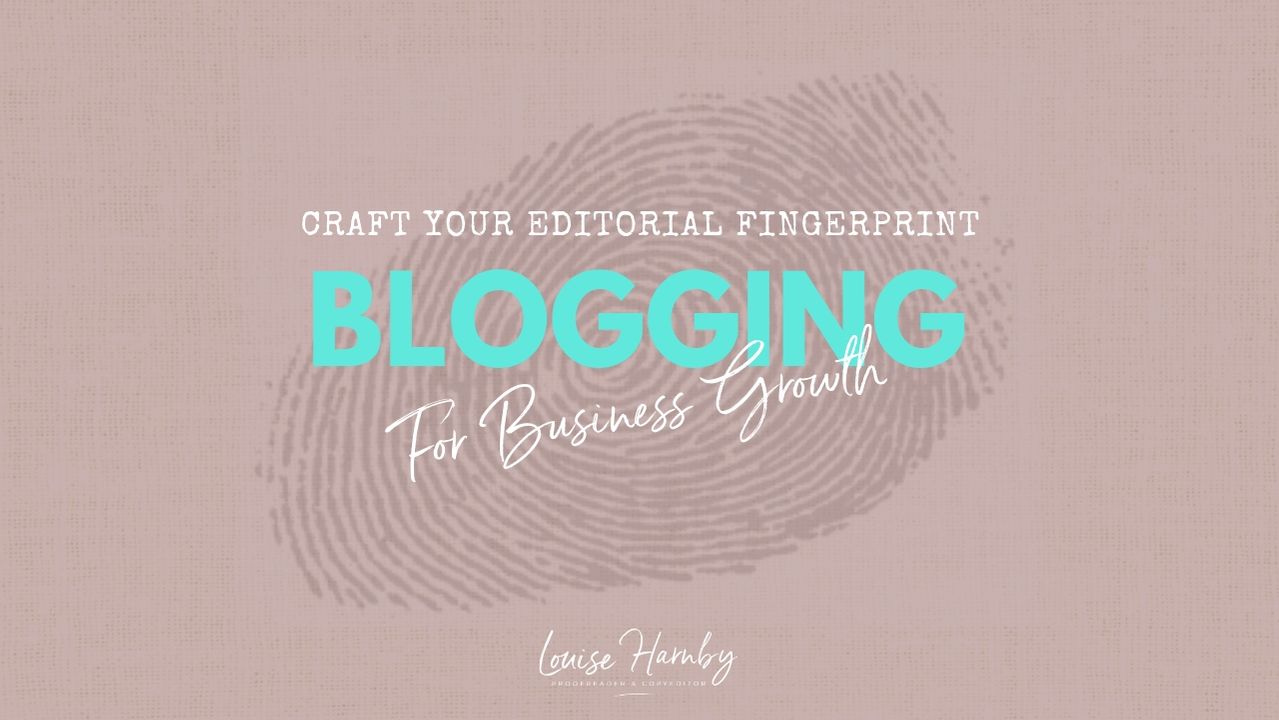|
Are your hyphens, en dashes and em dashes giving you the run-around? Here’s a guide to conventional usage in UK and US fiction publishing. Terminology
Both terms are acceptable but I’ll use ‘dash’ in this article. A word on exceptions What do the dashes look like?
Dashes that set off text and replace alternative punctuation That old dog (the black one) is as sweet as they come. In the UK, it’s conventional to use a SPACED EN DASH. This is not the law, not a rule, not the only way or the right way. It’s just the style that many UK publishers choose, though not all. The yard – every single blade of grass seeming to cast a shadow in the moonlight – was empty. In the US, it’s conventional to use a CLOSED-UP EM DASH. Again, this is not the law, not a rule, not the only way or the right way. It’s just the style that many US publishers choose, though not all. Here’s what King’s sentence looks like when amended according to US convention: The yard—every single blade of grass seeming to cast a shadow in the moonlight—was empty. Some style guides even ask for SPACED EM DASHES, though I see this usage less frequently: The yard — every single blade of grass seeming to cast a shadow in the moonlight — was empty. I recommend you stick to spaced en dashes or closed-up em dashes in fiction because that’s what your readers will be most familiar with. As for which style you should choose, think about:
If you’re publishing internationally, pick one style and be consistent. Dashes in number spans Morning registration: 9.30–11.30 (full stops more often used in time styles in UK English)
07/03/1967–26/06/2019 (day/month/year; standard in UK English) Note that the en dash means up to and including (or through in US English). CMOS and NHR both recommend using EITHER the closed-up en dash in a number range OR a from/to or between/and construction, but not a mixture of the two: Read from p. 86 to p. 95 (standard) Dashes as alternative speech marks Sylvain Neuvel uses this technique in Sleeping Giants and it works because the scenes in which it occurs take place in a secret location with an anonymous (even to the reader) agent running the interrogation. Each speaker’s turn is indicated with an em dash. The agent’s speech is rendered in bold. Excerpt from the Kindle edition: It can be an effective tool for fiction that’s dialogue driven – almost like a screenplay – but it gets messy when there are more than two speakers in a conversation, and becomes unworkable if you want to ground your dialogue in the environment with narrative (action beats, for example). And, of course, the dialogue needs to be standout because that’s all there is. Dashes that indicate end-of-line interruptions
Here’s an example from Mick Herron’s ‘I got the guys at the Troc to pick it up on Clerkenwell Road. They tracked—’ And another from Linwood Barclay’s Parting Shot (p. 380): “Ms. Plimpton,” Duckworth said. “I don’t know if you remember me, but I’m Detective Barry—” Dashes for dialogue interrupted by narrative description “We’ve talked about this monstrosity before”—he jabbed at the flock wallpaper—“and I’m telling you, it has to go.” And if you’re following UK English convention, use SPACED EN DASHES: ‘We’ve talked about this monstrosity before’ – he jabbed at the flock wallpaper – ‘and I’m telling you, it has to go.’
Notice how I’ve also used double quotation marks in the US version and singles for the UK one. Again, this isn’t about being right or obeying a rule; it’s a convention, and one that’s not always adhered to. Consistency is king. Dashes that indicate faltering speech
If you want to denote a staccato rhythm, HYPHENS are a good choice. This works for If the faltering related not to letters but to phrases, you could use a CLOSED-UP EM DASH (US style) or a SPACED EN DASH (UK style). Ellipses are another option. They're not dashes but they're handy for faltered speech that has a pause in it. You can use these with your dash of choice. Hyphens (staccato):
Closed-up em dash for faltering phrasing (US style):
Spaced en dash for faltering phrasing (UK style):
Ellipses for pauses (in conjunction with dashes):
"No. I ... I mean, not really. It was an accident. I just s-s-saw him standing there and I flipped," Marion said.
‘No,’ Louise said. ‘That’s not how you spell it. It’s T-O-M-A-S.’
“That doesn’t make sense. The extension he gave me is 1-9-1-8. Are you sure it’s a five-digit number?” Number separation comes in handy when you want to ensure your reader reads the numbers as distinct digits rather than inclusively. Compare 1918 (nineteen eighteen) with 1-9-1-8 (one, nine, one, eight). Dashes that indicate connection, relation or an alternative They’d nurtured that author–editor relationship for years.
“Those two have had an on–off relationship for over a decade. I wish they’d make their minds up!”
‘I’m going to get the Liverpool–Belfast ferry. There’s one at ten thirty.’
I couldn’t see us winning the England–Brazil match but I put a tenner on us anyway. Just for fun. Dashes with adjectival compounds He buttoned up a navy-blue shirt. Care should be taken, even in fiction, with regard to weighting. Let’s revisit the example of our polyglot Amir. Consider the differences between the following: Amir was an Asian–British scholar and something of a polyglot. ‘Languages float on the wind in my grandparents’ village,’ he once told me.
Amir was an Asian-British scholar and something of a polyglot. ‘Languages float on the wind in my grandparents’ village,’ he once told me.
Amir was an Asian British scholar and something of a polyglot. ‘Languages float on the wind in my grandparents’ village,’ he once told me. In the first example, with an EN DASH, Amir’s Asianness and Britishness have equal weighting. In the second, with the HYPHEN, ‘Asian’ is modifying ‘British’ and carries less weight. In the third and fourth, where the dashes are omitted, the weighting is ambiguous. The dash of choice (or its omission) can tell us something about Amir’s identity – how he, or the narrator, or the author perceives this – so it needs to be used purposefully. Dashes indicating omission
There are several options for managing omission: em dashes, 2em dashes, en dashes and asterisks. Spacing comes into play. There are different conventions for US and UK style. To indicate partial omission of a word, and the number of letters that have been omitted, choose the SPACED EN DASH (or unspaced asterisks):
‘The scandal featured a certain Mrs H – – – – –. Can you believe it?’
To indicate partial omission of a word with a single mark, choose the CLOSED-UP EM DASH:
To indicate complete omission of a word with a single mark, choose the SPACED EM DASH:
CMOS recommends the following for US style: To indicate partial omission of a word, choose a CLOSED-UP 2EM DASH:
“The scandal featured a certain Mrs H⸺. Can you believe it?”
To indicate complete omission of a word, choose the SPACED 2EM DASH:
“The scandal featured a certain Mrs ⸺. Can you believe it?” Summing up
Consider, too, whether your choice of dash will amplify or reduce the significance (or weight) of your words when you’re using dashes as connectors or modifiers.
Hi, Louise Harnby 4/9/2019 07:52:34 pm Hi, MJ. There are various options. It depends on the faltering. I've amended the post to show some different options, including for stuttered speech. See the heading 'Dashes that indicate faltering speech'. Hope that helps!
I use word. I can create an em- dash, and a hyphen is easy, but I have no idea how to create an en- dash. Louise Harnby 4/9/2019 10:48:30 pm
Hi, Vivienne. See New Hart's Rules published by Oxford. Here's a quotation the uses the term 'rule': It also gives you the unicode you can search for in the Symbols window (click on Insert, then Symbols). I've set up a keyboard shortcut to create en and em dashes, though in my version of Word the en appears automatically if I type a word followed by a space followed by another word. Hope that helps. David J 10/9/2023 11:18:59 pm In Word, use ctrl+- for an en dash and alt+ctrl+- for an em dash, where "+" means hold the keys down together and "-" means the minus character on the numerical keypad. Erin 8/9/2019 02:53:06 am
This is probably the clearest article on this that I've found! It's also super helpful to see which conventions are more popular in which area of the world. Very helpful, thank you. Louise Harnby 9/9/2019 04:56:40 pm Thanks, Erin! I expanded NHR on first use and meant to follow suit with CMOS. Just a little slip-up. I admit, however, that I thought CMOS was as well known to UK editors as US ones! I'm a British editor and I use it every day because it's so comprehensive. That'll teach me not to make assumptions! Thanks for the heads-up! Excellent article Louise. It's clearly explained and will be very helpful. best wishes Louise Harnby 11/9/2019 11:45:11 am Thanks so much, Suzanne! Simon Ellberger 23/5/2020 12:32:48 pm
What about a dash used as a terminal end point in a sentence that is not part of a dialogue. Louise Harnby 23/5/2020 01:31:03 pm Hi, Simon. It's an interesting style choice but one that might confuse readers precisely because there is existing standard punctuation to indicate a terminus: the full point. Dashes are usually interpreted as indicating either an interruption or some sort of open loop ... in other words the reader imagines there would/could have been more to say (either in dialogue or a narrative). So this would make sense to me:
He jumped into the waves and-- Now there's suspense because the reader's wondering: did he swim away, did he drown, did he nearly drown but manage to swim away? Something else? And perhaps that will be unveiled later but for now it's a mystery. But if he jumped into the waves and swam away, that's it - job done. An em dash would confuse me because I wouldn't understand what it was indicating. As for which dash, and whether to have a space, as I said in the blog post, it's a style choice but for open loops and direct interruptions, it's usually a closed-up em. However, I could imagine that kind of dash being used if a viewpoint character were remembering something but is then interrupted by a speaker or an event that distracts them from their musing. So, as an example in narrative:
He unfolded the picture. Him, Tom, Jerry. Just kids really. And carefree, their whole lives ahead of them. And then, in not two years later, Tom had jumped into the water and swum away-- So in that kind of situation, I'd use a closed-up em dash to show the interruption but leave the musing unresolved for the reader. Not sure if that helps! These kinds of decisions are so dependent on context. The post above aimed to give general guidelines that can be applied universally but there are always exceptions depending on what's going on in the story and what a writer's intention is. This article is precisely what I needed. Thank you so much for this :) Louise Harnby 5/6/2020 12:48:27 pm You're welcome! Jayne Lewis 7/8/2020 04:09:32 pm Signed up for my free trial of CMOS, received the activation link and… half an hour later it's still 'thinking about it'! A bit of googling, found your site instead and had my answer straight away, so many thanks. Louise Harnby 7/8/2020 06:18:23 pm I aim to please, Jayne! CMOS is worth waiting for though. Great resource that I turn to often! Thank you, I found this really useful when self-editing a third draft. Kitty 2/4/2021 08:06:22 pm
Ah, this is fantastic – thank you! I'm please to see that I was already mostly correct in what I was using.
Eldunai hadn’t realised she’d dropped her hand and stopped breathing. She became suddenly aware of how hard her heart was beating. Louise Harnby 2/4/2021 08:51:01 pm I'd say it's a style choice, Kitty, and depends whether the question mark is absolutely necessary for sense. I don't have enough context to make a judgement call here so I'll leave it to you! Either choice is fine grammatically though. Kitty 3/4/2021 03:52:48 am Ah, brilliant! In this case, I think I'll keep it. Thank you so much! Lily 21/4/2021 05:54:56 am How do I format the dash in this correctly? It's rather important for my novel, and I'm only 13 so I'm not amazing/experienced at grammar. Thank you.
Back then, she had gotten upset, and he had hugged her, forced all the sadness out until there were only tear stains to remind her of what she had felt. She tried to concentrate on that moment, tried to remember what had made her feel upset, why she had-- Louise Harnby 21/4/2021 08:11:12 am Hi, Lily. You need the em dash. See the section in the post called: 'Dashes that indicate end-of-line interruptions' Mary McGovern 5/9/2024 07:29:17 pm Love your article. Very helpful! Thank you! Aimee 11/9/2024 04:39:27 am
Hi, if by chance you are still answering on this article, I have a question. In a work of fiction, could a hyphen be used to enhance the way a compound noun is read. E.g "Pah! Singed jungle-cat(Em dash)go now!" Leave a Reply. |
.png)

